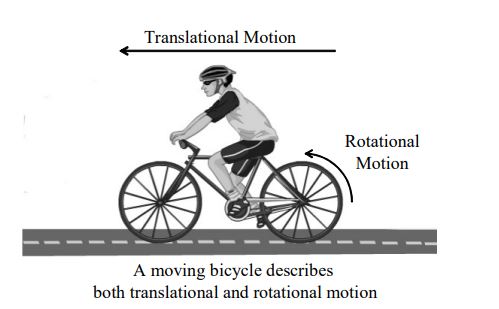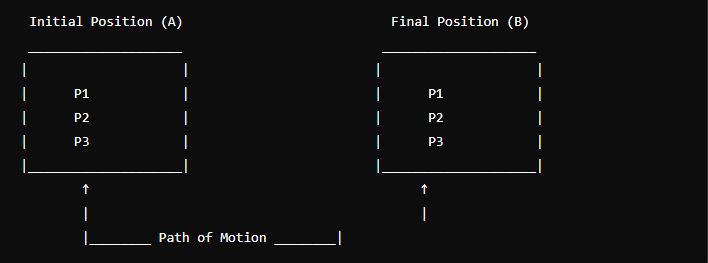A type of motion known as translatory motion occurs when every point on a moving body moves equally in the same direction. When a body moves in a translatory manner, its orientation with regard to a fixed point remains unchanged. If an object travels so that every particle inside it moves parallel to every other particle, the object is said to be in translatory motion. When moving in translation,

Table of Contents
Translatory Motion
Movement where a moving body moves equally in one direction at all of its points. We can observe that there is no shift in the object’s orientation when it is undergoing translatory motion. Translational motion is another term for translatory motion.
When all of the particles in a body move in parallel, the item is said to be in perfect translatory motion.
As an illustration, picture a solid block situated on the right-angled triangle’s slanting edge. Every point in the rectangular block moves in the same way that the solid block slides along the edge of the right-angled triangle. Every spot on the body feels the same velocity at every instant in a perfect translatory motion. The movements that occur at P1 and P2 are identical. A solid block’s translatory motion is depicted in the image below.
Diagram of Translatory Motion
Here’s a simple description of how you might draw a diagram for translatory motion:- Draw an Object: Start with a simple shape, like a rectangle or a square, to represent an object.
- Initial Position: Draw the object in its initial position. Label it as AAA.
- Final Position: Draw the object in its final position. Label it as BBB.
- Path: Draw a straight or curved arrow between the initial and final positions to show the direction of motion.
- Points on the Object: Indicate several points on the object (e.g., P1P_1P1, P2P_2P2, P3P_3P3).
- Movement: Use arrows to show that all points P1P_1P1, P2P_2P2, and P3P_3P3 move in parallel paths from position AAA to BBB.

- Initial Position (A): The shape with points P1P1P1, P2P2P2, and P3P3P3 is in its starting position.
- Final Position (B): The shape has moved to a new position, but P1P1P1, P2P2P2, and P3P3P3 are still aligned in parallel paths.
This illustration shows that in translatory motion, all parts of the object move uniformly and maintain their relative positions.
Translatory Motion Example
Translatory motion is a type of motion where all parts of an object move uniformly in the same direction. Here are a few examples to illustrate translatory motion:
1. Sliding a Book Across a Table
- Description: When you slide a book from one side of a table to the other, every point on the book moves in the same direction and by the same distance.
- Motion Type: Rectilinear translatory motion (since the book moves in a straight line).
2. Car Moving on a Straight Road
- Description: A car traveling on a straight, level road experiences translatory motion. Each point on the car (e.g., the headlights, the tires) moves forward by the same amount.
- Motion Type: Rectilinear translatory motion.
3. Elevator Moving Up or Down
- Description: An elevator moving vertically up or down in a building’s shaft exhibits translatory motion. Every part of the elevator (floor, walls, and ceiling) moves up or down together.
- Motion Type: Rectilinear translatory motion.
4. Conveyor Belt in a Factory
- Description: A conveyor belt transporting goods moves every point on the belt in the same direction. Items placed on the conveyor belt also move in the same direction as the belt.
- Motion Type: Rectilinear translatory motion.
5. A Hockey Puck Sliding on Ice
- Description: When a hockey puck slides across the ice, every point on the puck follows the same direction and distance as it travels.
- Motion Type: Rectilinear translatory motion.

Initial Position:
- The book is at position AAA on the table.
Final Position:
- After sliding, the book is at position BBB. The motion is shown by the arrow indicating the direction of movement.
Curvilinear Motion
One type of Translatory Motion is Curvilinear Motion, where an object moves along a curved path. It is a type of motion where the body or item moves along a predetermined, well-known path. In addition to moving in a curved path, a body moving in a curvilinear motion also advances in a straight line.
Curvilinear motion examples include
The roller coaster’s motion.
A penny flung into the atmosphere.
Curvilinear motion is demonstrated by an automobile turning on a road.
Every point on the object in the aforementioned instances moves in a way that causes it to follow a predetermined curve path.

Comparison of Rectilinear and Curvilinear Motion
Comparison of Rectilinear and Curvilinear Motion
Rectilinear Motion
| Definition | Motion along a straight line. |
|---|---|
| Characteristics |
|
| Examples |
|
| Diagram | Initial Position Direction of Motion → → → → → → Final Position |
Curvilinear Motion
| Definition | Motion along a curved path. |
|---|---|
| Characteristics |
|
| Examples |
|
| Diagram | Initial Position Direction of Motion → → → → → → Final Position |
Comparison Summary
| Aspect | Rectilinear Motion | Curvilinear Motion |
|---|---|---|
| Path | Straight line | Curved path |
| Velocity | Constant in magnitude and direction if uniform; otherwise, changing linearly | Magnitude can be constant or changing; direction changes continuously |
| Acceleration | Can be constant or varying in magnitude and direction; direction is consistent with the straight path | Always includes centripetal acceleration towards the center of curvature; direction changes to remain perpendicular to the velocity |
| Examples | Straight-line movement like a car on a straight road | Movement along a curve like a car taking a turn or a ball in projectile motion |
Sample Questions Translatory Motion
Basic Concept Questions
Definition Question:
- Q: What is translatory motion, and how does it differ from rotational motion?
- A: Translatory motion is the movement of an object along a straight or curved path where every point on the object moves in the same direction and by the same distance. It differs from rotational motion, where different points on an object move in circular paths around an axis.
Characteristics Question:
- Q: List three key characteristics of translatory motion.
- A: The three key characteristics of translatory motion are:
- The path of the object is either straight (rectilinear) or curved (curvilinear).
- Every point on the object moves in the same direction and by the same distance.
- The velocity and direction are uniform across all points on the object in rectilinear motion, whereas in curvilinear motion, the direction changes continuously.
2. Calculation and Application Questions
Velocity and Distance Question:
- Q: A car travels in a straight line at a constant speed of 60 km/h for 2 hours. Calculate the distance traveled by the car.
- A: Distance = Speed × Time = 60 km/h × 2 h = 120 km.
Acceleration Question:
- Q: A bicycle accelerates uniformly from rest to a speed of 15 m/s in 5 seconds. Calculate the acceleration of the bicycle.
- A: Acceleration = (Final Velocity – Initial Velocity) / Time = (15 m/s – 0 m/s) / 5 s = 3 m/s².
Displacement Question:
- Q: A person walks in a straight line from point A to point B, covering a distance of 500 meters in 10 minutes. What is the average velocity of the person?
- A: Average Velocity = Displacement / Time = 500 meters / 10 minutes = 50 meters/minute.
3. Conceptual Understanding Questions
Translatory Motion vs. Rotational Motion Question:
- Q: Explain why a spinning top does not exhibit translatory motion.
- A: A spinning top does not exhibit translatory motion because its motion is primarily rotational. The top spins around its axis, and different points on its surface follow circular paths rather than moving in the same direction and distance.
Real-life Example Question:
- Q: Describe a real-life scenario where an object undergoes curvilinear translatory motion and explain the path it follows.
- A: A real-life scenario of curvilinear translatory motion is a car moving through a curved section of a road. As the car turns, it follows a curved path, and every part of the car moves along the same curved trajectory, changing direction continuously.
